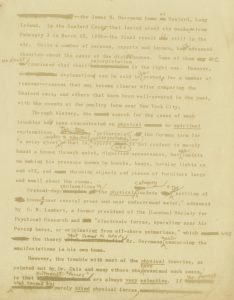The Seaford Poltergeist was used as a point of comparison for other reported poltergeists. The term “poltergeist” is a German loanword meaning “noisy ghost.” Various theories behind poltergeist activity are described, which many deemed unsatisfactory to fully explain these phenomena.
See: “The House of Knocks and Bumps” page 1, page 7, page 8
Manuscript, “The House of Knocks and Bumps,” Daniel Lehmann, pg. 2, Folder “Baltimore Poltergeist,” Box D, Eileen J. Garrett Parapsychology Foundation collection, Collection 331, Special Collections, University of Maryland, Baltimore County (Baltimore, MD).

